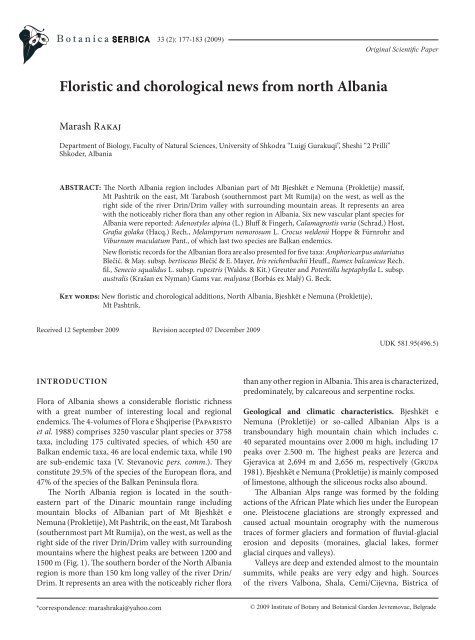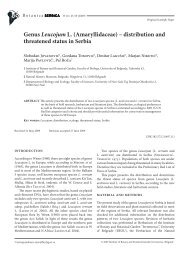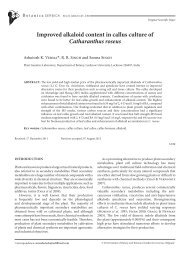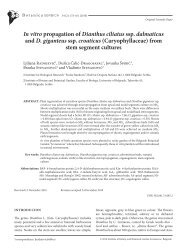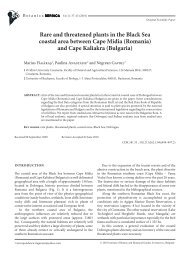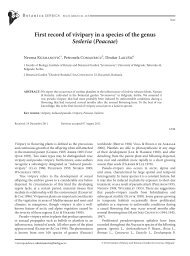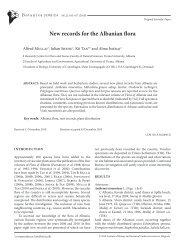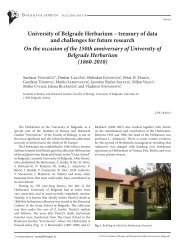Floristic and chorological news from north Albania - Botanica Serbica
Floristic and chorological news from north Albania - Botanica Serbica
Floristic and chorological news from north Albania - Botanica Serbica
Create successful ePaper yourself
Turn your PDF publications into a flip-book with our unique Google optimized e-Paper software.
33 (2): 177-183 (2009)<br />
<strong>Floristic</strong> <strong>and</strong> <strong>chorological</strong> <strong>news</strong> <strong>from</strong> <strong>north</strong> <strong>Albania</strong><br />
Marash Rakaj<br />
Department of Biology, Faculty of Natural Sciences, University of Shkodra “Luigj Gurakuqi”, Sheshi “2 Prilli”<br />
Shkoder, <strong>Albania</strong><br />
Received 12 September 2009 Revision accepted 07 December 2009<br />
Original Scientifi c Paper<br />
ABSTRACT: Th e North <strong>Albania</strong> region includes <strong>Albania</strong>n part of Mt Bjeshkët e Nemuna (Prokletije) massif,<br />
Mt Pashtrik on the east, Mt Tarabosh (southernmost part Mt Rumija) on the west, as well as the<br />
right side of the river Drin/Drim valley with surrounding mountain areas. It represents an area<br />
with the noticeably richer fl ora than any other region in <strong>Albania</strong>. Six new vascular plant species for<br />
<strong>Albania</strong> were reported: Adenostyles alpina (L.) Bluff & Fingerh, Calamagrostis varia (Schrad.) Host,<br />
Grafi a golaka (Hacq.) Rech., Melampyrum nemorosum L. Crocus weldenii Hoppe & Fürnrohr <strong>and</strong><br />
Viburnum maculatum Pant., of which last two species are Balkan endemics.<br />
New fl oristic records for the <strong>Albania</strong>n fl ora are also presented for fi ve taxa: Amphoricarpus autariatus<br />
Blečić. & May. subsp. bertisceus Blečić & E. Mayer, Iris reichenbachii Heuff ., Rumex balcanicus Rech.<br />
fi l., Senecio squalidus L. subsp. rupestris (Walds. & Kit.) Greuter <strong>and</strong> Potentilla heptaphylla L. subsp.<br />
australis (Krašan ex Nyman) Gams var. malyana (Borbás ex Malý) G. Beck.<br />
Key words: New fl oristic <strong>and</strong> <strong>chorological</strong> additions, North <strong>Albania</strong>, Bjeshkët e Nemuna (Prokletije),<br />
Mt Pashtrik.<br />
INTRODUCTION<br />
Flora of <strong>Albania</strong> shows a considerable fl oristic richness<br />
with a great number of interesting local <strong>and</strong> regional<br />
endemics. Th e 4-volumes of Flora e Shqiperise (Paparisto<br />
et al. 1988) comprises 3250 vascular plant species or 3758<br />
taxa, including 175 cultivated species, of which 450 are<br />
Balkan endemic taxa, 46 are local endemic taxa, while 190<br />
are sub-endemic taxa (V. Stevanovic pers. comm.). Th ey<br />
constitute 29.5% of the species of the European fl ora, <strong>and</strong><br />
47% of the species of the Balkan Peninsula fl ora.<br />
Th e North <strong>Albania</strong> region is located in the southeastern<br />
part of the Dinaric mountain range including<br />
mountain blocks of <strong>Albania</strong>n part of Mt Bjeshkët e<br />
Nemuna (Prokletije), Mt Pashtrik, on the east, Mt Tarabosh<br />
(southernmost part Mt Rumija), on the west, as well as the<br />
right side of the river Drin/Drim valley with surrounding<br />
mountains where the highest peaks are between 1200 <strong>and</strong><br />
1500 m (Fig. 1). Th e southern border of the North <strong>Albania</strong><br />
region is more than 150 km long valley of the river Drin/<br />
Drim. It represents an area with the noticeably richer fl ora<br />
✳ correspondence: marashrakaj@yahoo.com<br />
UDK 581.95(496.5)<br />
than any other region in <strong>Albania</strong>. Th is area is characterized,<br />
predominately, by calcareous <strong>and</strong> serpentine rocks.<br />
Geological <strong>and</strong> climatic characteristics. Bjeshkët e<br />
Nemuna (Prokletije) or so-called <strong>Albania</strong>n Alps is a<br />
transboundary high mountain chain which includes c.<br />
40 separated mountains over 2.000 m high, including 17<br />
peaks over 2.500 m. Th e highest peaks are Jezerca <strong>and</strong><br />
Gjeravica at 2,694 m <strong>and</strong> 2,656 m, respectively (Gruda<br />
1981). Bjeshkët e Nemuna (Prokletije) is mainly composed<br />
of limestone, although the siliceous rocks also abound.<br />
Th e <strong>Albania</strong>n Alps range was formed by the folding<br />
actions of the African Plate which lies under the European<br />
one. Pleistocene glaciations are strongly expressed <strong>and</strong><br />
caused actual mountain orography with the numerous<br />
traces of former glaciers <strong>and</strong> formation of fl uvial-glacial<br />
erosion <strong>and</strong> deposits (moraines, glacial lakes, former<br />
glacial cirques <strong>and</strong> valleys).<br />
Valleys are deep <strong>and</strong> extended almost to the mountain<br />
summits, while peaks are very edgy <strong>and</strong> high. Sources<br />
of the rivers Valbona, Shala, Cemi/Cijevna, Bistrica of<br />
© 2009 Institute of Botany <strong>and</strong> <strong>Botanica</strong>l Garden Jevremovac, Belgrade
178 vol. 33 (2)<br />
Fig. 1. Th e North <strong>Albania</strong> region<br />
Peja/Pečka Bistrica) <strong>and</strong> some other, are situated in high<br />
mountain parts of Bjeshket e Nemuna (Prokletije). Th ese<br />
rivers formed deep canyons <strong>and</strong> gorges of which some are<br />
c. 1000 m deep. A plenty of glacial lakes are also present<br />
in these mountains. For instance, only in the area of the<br />
mountain peak Jezerce (Buni of Jezerca), six small glacial<br />
lakes occurred.<br />
Th e geological substrate of the North <strong>Albania</strong> is<br />
complex: limestone <strong>and</strong> dolomites, diabase-chert<br />
formation, argiloschists, ultrabasic or serpentine rocks,<br />
s<strong>and</strong>stone <strong>and</strong> conglomerate are to be found (Vranaj<br />
1990).<br />
Th e North <strong>Albania</strong> mountain region belongs to<br />
Dinaric Mountain transitional eco-region (Hoda 1992).<br />
It is characterized mainly by Alpine relief, alpine karst<br />
hydrography, as well as by very rich fl ora with numerous<br />
endemics <strong>and</strong> Alpine plant species. A transitional climate<br />
between perhumid sub-Mediterranean <strong>and</strong> humid<br />
mountain climate of the Alpine type is dominant (Gruda<br />
1981).<br />
Phytogeographical characteristics. Flora of the <strong>Albania</strong>n<br />
Alps is one of the richest in the Balkan. Approximately<br />
1.611 wild vascular plant species <strong>and</strong> intraspecifi c taxa<br />
are described <strong>and</strong> recorded, which constitutes over 50% of<br />
<strong>Albania</strong>n fl ora. Th ese plants belong to 690 genera <strong>and</strong> 150<br />
families. Particularly signifi cant are the numerous Tertiary<br />
<strong>and</strong> glacial relics, while 250 species are Balkan endemics,<br />
comprising 136 regional <strong>and</strong> 17 local endemics distributed<br />
only in Mt Bjeshkët e Nemuna (Prokletije), such as: Crepis<br />
bertiscea Jáv., Ligusticum albanicum Jáv., Lunaria telekiana<br />
Jáv., Valeriana bertiscea Pančić, Pedicularis ernesti-mayeri<br />
Stevanović, Heliosperma oliverae, Wulfenia baldaccii Degen,<br />
etc. (Ruci & Vangjeli 2001; Stevanović 2002).<br />
Th e natural potential vegetation is represented by<br />
the following communities Fagetum montanum, Abieti-<br />
Fagetum, Piceetum excelsae montanum, Pinetum mugi,<br />
Pinetum peucis, Pinetum heldreichii, Oxytropidon dinaricae.<br />
According to Ruci & Vangjeli (2001) 161 plant communities<br />
are described in this region of <strong>Albania</strong>.<br />
Th e dominant habitat types are forests of the Turkey<br />
oak, Macedonian oak, Sessile oak, beech, Bosnian pine,<br />
Macedonian pine, as well as alpine <strong>and</strong> sub-alpine calcareous<br />
grassl<strong>and</strong>s. Above the forest belt, there are various shrubby<br />
communities, mainly dominated by Siberian juniper<br />
(Juniperus sibirica) <strong>and</strong> blueberries (Vaccinium spp.).<br />
Riparian or fl ooded vegetation, as Salicetum eleagni,<br />
Salicetum fragilis <strong>and</strong> Alnetum incanae is distributed along<br />
the river valleys (Ruci & Vangjeli 2001).<br />
Th e North <strong>Albania</strong>n region, situated at the crossroads of<br />
several plant migration routes, is one of the most important<br />
refugium in the Balkans <strong>and</strong>, probably, in whole S. Europe.<br />
It is the most important region both for preservation of<br />
plants during Ice Age <strong>and</strong> for plant speciation. Mountains<br />
of the North <strong>Albania</strong> could be regarded as a corridor for<br />
the migrations of plants <strong>from</strong> the Alps towards the south-<br />
<strong>and</strong> eastward regions.<br />
According to Ruci & Vangjeli (2001) the following<br />
fl oristic spectrum was recorded in the investigated area:<br />
European mountains (Central <strong>and</strong> Alpine) fl oristic<br />
element 22%, Eurasian 24.5% (Wulfenia, Forsythia,<br />
Gymnospermium, Ramonda, Aesculus, Dioscorea, Aster<br />
etc.), Boreal 9.3%, Mediterranean 12.5%, Balkan endemics<br />
28% <strong>and</strong> 3.7% of other ones.<br />
Th e presence taxonomically isolated endemo-relict <strong>and</strong><br />
relict species (Pinus heldreichii Christ, Pinus peuce Griseb.,<br />
Narthecium scardicum Košanin, Taxus baccata L., Forsythia<br />
europaea Deg. & Bald., Silene asterias Griseb., Edraianthus<br />
graminifolius (L.) DC., Acer heldreichii Orph., Juglans regia<br />
L., Asarum europaeum L., Campanula lingulata Waldst.<br />
et Kit., Valeriana pancicii Hal. et Bald., Rumex balcanicus<br />
Rech., Ramonda serbica Pančić, Ostrya carpinifolia<br />
Scop., Jasione orbiculata Griseb. ex Velen.), as well as the<br />
existence of fl oristic affi nities with ancient Mediterranean<br />
<strong>and</strong> sub-Mediterranean fl ora indicate that speciation of<br />
the <strong>Albania</strong>n fl ora have began since the Tertiary period.<br />
Th e occurrence of common sub-endemic taxa in<br />
the Balkans <strong>and</strong> Apennine peninsula point to ancient<br />
amphiadriatic fl oristic link. Th e typical sub-endemic<br />
species having disjunct ranges (or Apennine-Scardo-<br />
Pindhic, Illyrian-Scardo-Pindhic-Apennine, Illyrian-<br />
Apennine, Subscardo-Pindhic-South Apennine, etc), are:<br />
Pinus heldreichii Crist., Pinus nigra Arnold, Quercus trojana<br />
Webb, Drypis spinosa L. subsp. linnaeana Murb., Geum<br />
molle Vis. et Pančić, Potentilla apennina Ten., Anemone<br />
apennina L., Hypericum barbatum Jacq., Pinguicula<br />
hirtifl ora Ten., Asyneuma pichleri (Vis.) D. Lakušić &
F. Conti, Campanula lingulata Waldst. et Kit., Jasione<br />
orbiculata Griseb., Cardamine glauca Spreng., Doronicum<br />
columnae Ten., etc.<br />
Pleistocene glaciations strongly eff ected on the current<br />
composition of the North <strong>Albania</strong>n mountain fl ora, as<br />
well as on the whole Balkan fl ora. Th e numerous species<br />
remained here aft er glaciers melted, such as: Potentilla<br />
crantzii (Crantz)Beck, Arabis alpina L., Arctostaphylos<br />
alpinus (L.) Spreng., Aster alpinus L., Saxifraga aizoides L.,<br />
Saxifraga oppositifolia L., Salix retusa L., Salix reticulata L.,<br />
Dryas octopetala L., Androsace villosa L., Geum montanum<br />
L., Polygonum viviparum L., Trollius europaeus L., Parnassia<br />
palustris L., Veronica alpina L., Pedicularis verticillata L.<br />
Nigritella nigra (L.) Reichenb., Juncus trifi dus L., Poa alpina<br />
L., Luzula spicata DC., Selaginella selaginoides (L.) Schrank.<br />
& C. F. P. Mart etc. Stevanović et al. (2009) recorded c. 50<br />
Arctic-Alpine plants in Mt Prokletije. Th e majority of the<br />
above mentioned plants are glacial relicts.<br />
Th e North <strong>Albania</strong>n fl ora is characterised by a high<br />
number of isolated endemic species. Approximately 110<br />
Balkan endemics have <strong>north</strong>ern, eastern or southern<br />
limits of distribution in N <strong>Albania</strong> that is of special<br />
phytogeographical interest (Ruci & Vangjeli 2001). Th e<br />
<strong>north</strong>ernmost limit of distribution is characteristic for<br />
Alchemilla albanica Rothm., Minuartia baldaccii subsp.<br />
skutariensis Hayek, Ranunculus degenii Kümmerle &<br />
Jav., Ranunculus hayekii Dörfl er, Viola kosaninii (Degen)<br />
Hayek etc), Viola dukadjinica W. Becker et Bornm., while<br />
the eastern- or southernmost limits have Cerastium<br />
dinaricum G. Beck et Szyszyl., Edraianthus serpyllifolius<br />
(Vis.) A. DC., Edraianthus tenuifolius (Waldst. & Kit) A.<br />
DC., Gentiana dinarica G. Beck, Petasites doerfl eri Hayek,<br />
Minuartia velenovskyi (Rohlena) Hayek, Teucrium arduini<br />
L., Verbascum nicolai Rohlena etc.<br />
Th e number of plant endemic species in whole Mt<br />
Prokletije massif is particularly high. Approximately 17<br />
local endemic species are known, as: Alchemilla bertiscea<br />
Martinčič, Crepis bertiscea Jáv., Dianthus behriorum<br />
Bornm, Hieracium wettsteinianum Hayek & Zahn subsp.<br />
wettsteinianum, H. guentheri-beckii subsp. phaedroleucum<br />
Hayek & Zahn., H. chloropannosum Zahn, H. geminum<br />
Hayek & Zahn, H. fritschianum Hayek & Zahn, Ligusticum<br />
albanicum Jav., Lunaria telekiana Jav., Pedicularis ernestimayeri<br />
Stevanović, Niketić & D. Lakušić, Sesleria wettsteinii<br />
Dörfl er & Hayek, Heliosperma macranthum Pančić,<br />
Valeriana bertiscea Pančić, Wulfenia baldaccii Degen,<br />
Viola vilaensis Hayek, etc. Th ree centres of endemism can<br />
be distinguished according to number <strong>and</strong> distribution of<br />
the regional <strong>and</strong> local endemic plant taxa <strong>from</strong> the North<br />
<strong>Albania</strong> region:<br />
1.<br />
Mt Bjeshkët e Nemuna (Prokletije) – a big isolated<br />
mountain massif mainly made of calcareous (limestone<br />
<strong>and</strong> dolomite) substratum, represented by numerous<br />
2.<br />
3.<br />
M. Rakaj: <strong>Floristic</strong> <strong>and</strong> <strong>chorological</strong> <strong>news</strong> <strong>from</strong> <strong>north</strong> <strong>Albania</strong><br />
regional <strong>and</strong> local paleo- <strong>and</strong> neo-endemic species,<br />
being an important centre of plant speciation <strong>and</strong><br />
refugium;<br />
Tropoja Valley, Bytyçi <strong>and</strong> White Drin Valley – a great<br />
serpentine area, represented also by numerous regional<br />
paleo- <strong>and</strong> neo-endemic taxa <strong>and</strong> few local endemics.<br />
It is important refugium (south-<strong>north</strong> corridor) of<br />
serpentine elements, as well as the speciation centre.<br />
Has region, including Mt Pashtrik – mainly made of<br />
limestone, with few stenoendemic species.<br />
However, the occurrence of the endemic species, such<br />
as Asperula scutellaris Vis., Crepis baldaccii Halácsy subsp.<br />
albanica Jáv., Edraianthus serpyllifolius (Vis.) A. DC.,<br />
Phyteuma pseudorbiculare Pant., Pimpinella serbica (Vis.)<br />
Bentham & Hooker fi l. ex Drude, Potentilla montenegrina<br />
Pant., Valeriana bertiscea Pančić, etc. confi rm fl oristic<br />
connection between N <strong>Albania</strong> <strong>and</strong> surrounding parts of<br />
the Balkans (Dinaric Alps <strong>and</strong> Scardo-Pindhian mountain<br />
system).<br />
Th erefore, this region is of a particular phytogeographical<br />
interest as a barrier for a numerous Mediterranean<br />
plant species, <strong>from</strong> one side, <strong>and</strong> an important<br />
distribution corridor for orophytes <strong>from</strong> N Dinaric Alps<br />
towards south (Albanids, Pindhos) <strong>and</strong> east (Mt Shar<br />
Planina), as well as vice-versa, <strong>from</strong> the other side.<br />
History of investigation. Th e fi rst fl oristic data for North<br />
<strong>Albania</strong>n fl ora have been obtained by Grisebach (1843,<br />
1844) in the middle of the XIX century. Th e serious work on<br />
fl ora <strong>and</strong> vegetation begun in the fi rst part of the XX century,<br />
when noumerous botanists, such as Degen & Dörfler<br />
(1897), Baldacci (1904), Janchen (1916), Hayek (1917,<br />
1924), Jávorka (1921), Jávorka et al. (1926), Markgraf<br />
(1931), Bornmüller (1933), Rechinger (1935), Lemperg<br />
(1937), Košanin (1939), Rohlena (1942), etc., started the<br />
botanical explorations of this region. Th ey recorded <strong>and</strong><br />
described numerous new plant species, including local<br />
endemics, as Wulfenia baldaccii Degen, Petasites doerfl eri<br />
Hayek, Centaurea kosaninii Hayek, Crepis bertiscea Jáv.,<br />
Ligusticum albanicum Jáv., Polygala doerfl eri Hayek,<br />
Sanguisorba albanica Andrasovszky <strong>and</strong> Jáv., etc.<br />
In the last three decades a number of <strong>Albania</strong>n<br />
botanists have also investigated this area <strong>and</strong> published<br />
their own studies, such as Demiri (1983), Ruci (1986),<br />
Paparisto et al. (1988), Hoda (1992), Qosja et al. (1992,<br />
1996), Vangjeli et al. (2000), Ruci & Vangjeli (2001),<br />
Rakaj & Kashta (2003, 2007), Rakaj (2006), Kashta<br />
(2007), Barina & Pifko (2008a, 2008b) etc. In this region<br />
several new taxa for <strong>Albania</strong>n fl ora were recorded during<br />
the last decade: Dianthus behriorum Bornm, Hyacinthella<br />
dalmatica (Baker) Chouard., Lathraea squamaria L.,<br />
Parietaria lusitanica L., Prunus tenella Batsch, Ranunculus<br />
montanus Willd.<br />
179
180 vol. 33 (2)<br />
It is worth to mention that the fl ora <strong>and</strong> vegetation<br />
of the <strong>north</strong>ern parts of Mt Prokletije <strong>and</strong> Mt Pashtrik,<br />
outside <strong>Albania</strong>, were also investigated in more details by<br />
some ex-Yugoslav botanists: Lakušić (1971), Wraber<br />
(1986, 1989), Martinčič (1990), Lakušić & Stevanović<br />
(1995), Stevanović (1999), Stevanović & Lakušić<br />
(2000), Stevanović et al. (2002, 2003), Lakušić et<br />
al. (2004), Niketić (2005), Niketić & Stevanović<br />
(2006), etc. Th ey found seven new local endemic species:<br />
Alchemilla bertiscea Martinčič, Cynoglossum krasniqii<br />
T. Wraber, Draba bertiscea D. Lakušić & Stevanović,<br />
Draba kuemmerlei Stevanović & D. Lakušić, Hieracium<br />
bertisceum Niketić, Heliosperma oliverae Niketić &<br />
Stevanović, Pedicularis ernesti-mayeri Stevanović, Niketić<br />
& D. Lakušić. Most of them were found in close proximity<br />
of the <strong>Albania</strong>n territory, so it is probable to assume that<br />
some of these taxa will be recorded in <strong>Albania</strong> too.<br />
MATERIALS AND METHODS<br />
Th e results of the present paper are based mainly on<br />
personal investigations <strong>and</strong> collecting plants material<br />
during the period of 2000-2009, <strong>and</strong> partly on the plant<br />
material stored in herbarium of Faculty of Natural Science,<br />
University of Shkodra, <strong>Albania</strong>. In addition, the literature<br />
data were used for the presentation of the distribution of<br />
the investigated taxa. Th e new plant species for <strong>Albania</strong> are<br />
mapped on UTM grid 10 x 10 sq. km.<br />
RESULTS AND DISCUSSION<br />
New taxa for the <strong>Albania</strong>n fl ora. <strong>Albania</strong>n fl ora, particularly,<br />
in mountain is not suffi ciently known. In this<br />
paper six new vascular plant taxa for <strong>Albania</strong>n fl ora were<br />
reported, including one new genus (Grafi a) (Fig. 2-4).:<br />
1. Adenostyles alpina (L.) Bluff & Fingerh: limestone, in<br />
high-mountain rocky grounds <strong>and</strong> screes on Mt Shtegu<br />
i Dhenve (UTM CM99), 1850m, coll. T. Wraber, M.<br />
Rakaj, 15.07.2002; Mt Maja Jezerce (UTM DM09),<br />
2340m, coll. B. Surina, M. Rakaj 16.08.2007; Mt<br />
Parun (UTM CM88), 1740m, coll. B. Surina, M. Rakaj<br />
18.08.2007 (Fig. 2).<br />
Th is species was known <strong>from</strong> Alps, N Apennines<br />
<strong>and</strong> NW Dinarides (Slovenia <strong>and</strong> Croatia). Th e new<br />
localities in <strong>Albania</strong>n Alps represent a very isolated<br />
disjunction on the eastern <strong>and</strong> southern part of the<br />
species range.<br />
2. Calamagrostis varia (Schrad.) Host: limestone, in<br />
high-mountain rocky grounds on Mt Shtegu i Dhenve<br />
(UTM CM99), 1700-1850m, coll. B. Surina, M. Rakaj<br />
15.08.2007; Mt Parun, (UTM CM88), 1640m, coll. B.<br />
Surina, M. Rakaj 18.08.2007 (Fig. 3).<br />
Eurasian species widespread in mountain areas of C <strong>and</strong><br />
Fig. 2. – Distribution of Adenostyles alpina (L.) Bluff & Fingerh<br />
in <strong>Albania</strong>.<br />
Fig. 3. – Distribution of Calamagrostis varia (Schrad.) Host in<br />
<strong>Albania</strong>.<br />
S Europe. It has been recorded in all Balkan countries,<br />
except in <strong>Albania</strong>. Collected samples belong to the type<br />
subspecies (subsp. varia).<br />
3. Crocus weldenii Hoppe & Fürnrohr: sunny hill slopes,<br />
grassy <strong>and</strong> stony places; Tarabosh, Goraj, Vrith (UTM<br />
CM65), 100 - 200m, coll. M. Rakaj, 22.02.2009;<br />
14.03.2009 (Fig. 4).<br />
Balkan endemic with general distribution in Slovenia,<br />
Croatia, Herzegovina, Montenegro, Serbia <strong>and</strong><br />
Macedonia.s North-western border of the species range<br />
reaches the vicinity of Trieste in NE Italy (Pulević<br />
1977, R<strong>and</strong>jelović et al. 1990). It is interesting to note<br />
that R<strong>and</strong>jelović et al. (1990) also cited <strong>Albania</strong> for<br />
general distribution but without any locality. Species<br />
belongs to C. bifl orus Mill. aggregate.<br />
4. Grafi a golaka (Hacq.) Rech.: limestone, on rocky<br />
ground next to Mt Shtegu i Dhenve (UTM CM99),<br />
1700m, coll. B. Surina, M. Rakaj, 15.07.2007 (Fig. 4).<br />
Apennine-Balkan (Dinaric) mountain species. Th e new<br />
discovered population in <strong>Albania</strong> is situated on the<br />
easternmost part of the species area, <strong>and</strong> also provides<br />
the south-easternmost border of the Balkan part of<br />
the area. Th is species has been also found in adjacent<br />
parts of Mt Prokletije in Montenegro (M. Niketić, pers.<br />
comm.).
Fig 4. – Distribution of Crocus weldenii Hoppe & Fürnrohr<br />
(black circle) <strong>and</strong> Grafi a golaka (Hacq.) Rech., Melampyrum<br />
nemorosum L. <strong>and</strong> Viburnum maculatum Pant. (triangle) in<br />
<strong>Albania</strong>.<br />
5. Melampyrum nemorosum L.: on calcareous rocks of<br />
west slopes under Shpella upper Okol (Th eth) (UTM<br />
CM99), 1450m, coll.: T. Wraber, M. Rakaj 16.07.2002;<br />
M. Rakaj, B. Surina 16.08. 2007 (Fig. 4).<br />
Widespread species in Europe, except on the West. It<br />
is also known <strong>from</strong> adjacent parts of Mt Prokletije in<br />
Montenegro (Rohlena 1942).<br />
6. Viburnum maculatum Pant.: limestone, on rocky<br />
grounds on Mt Maja Shtegut (Th eth) (UTM CM99),<br />
1500m; coll. S. Barina, M. Rakaj, 16.08.2007 (Fig. 4).<br />
Regional endemic outer chain of SE Dinaric Alps under<br />
strong Mediterranean climatic infl uence along Adriatic<br />
coast <strong>from</strong> Mt Orjen to Mt Rumija.<br />
Th e new discovered locality in <strong>Albania</strong> provides the<br />
southeasternmost border of the species area.<br />
New fl oristic records for the <strong>Albania</strong>n fl ora <strong>from</strong> North<br />
<strong>Albania</strong><br />
1. Amphoricarpus autariatus Blečić. & May. ssp. bertisceus:<br />
in stony places in the beech <strong>and</strong> pine forest on Th ore,<br />
1650m; bellow Qafa Pejes, 1600m; coll: B. Surina, M.<br />
Rakaj, 15, 08. 07. It is distributed southward to NW<br />
Greece. Regional endemic.<br />
2. Iris reichenbachii Heuff . (=Iris bosniaca Beck):<br />
limestone, in high-mountain pastures <strong>and</strong> rocky<br />
grounds on Mt Pashtrik (UTM DM67), 1750m, coll.<br />
T. Wraber, M. Rakaj, L. Kashta 07.06. 2001. Literature<br />
data: Mt Maja Gjallices, 1840m (Košanin 1939: 75).<br />
Balkan – S Carpatian fl oristic element.<br />
3. Rumex balcanicus Rech. fi l.: limestone, high mountains<br />
<strong>and</strong> rocky grounds of Mt Maja Malisores (UTM DM09),<br />
2300m; coll: M. Rakaj, 15.08. 08. Tertiary relict <strong>and</strong><br />
Balkan endemic distributed in SE Dinaric Alps <strong>and</strong> N<br />
Scardo-Pindhic mountains.<br />
4. Potentilla heptaphylla L. subsp. australis (Krašan ex<br />
Nyman) Gams var. malyana (Borbás ex Malý) G. Beck:<br />
M. Rakaj: <strong>Floristic</strong> <strong>and</strong> <strong>chorological</strong> <strong>news</strong> <strong>from</strong> <strong>north</strong> <strong>Albania</strong><br />
serpentine, in stony places in the bush on Cahan,<br />
Mici-Has (Has) (530-800m) <strong>and</strong> (Kolsh 470m) (UTM<br />
DM57), coll. T. Wraber, M. Rakaj, L. Kashta 23.07.<br />
2002. Literature data: Sk<strong>and</strong>erbeg (Stane të Frenkthit,<br />
serpentine) (Markgraf 1931, sub. P. australis).<br />
P. heptaphylla subsp. australis is a south European<br />
orophyte, with an ecotype (var. malyana) characteristic<br />
for serpentinite rocky ground in the W <strong>and</strong> C Balkan.<br />
5. Senecio squalidus L. subsp. rupestris (Walds. & Kit.)<br />
Greuter: on open grassy <strong>and</strong> calcareous rocks on Fusha<br />
e Runices 1750m (UTM CN90), coll. T. Wraber, M.<br />
Rakaj, 18.07.2000; Kroj i Kuq (Mt Gjallice) 2100m<br />
(UTM DM55); coll.: T. Wraber, M. Rakaj, 18.07.2000;<br />
05.06.2001. Literature data: Mt Maja Pashtrik (Košanin<br />
1939:75-105). Th is C <strong>and</strong> SE European orophyte is<br />
widespread through the Balkan mountains, particularly<br />
in the Dinaric Alps.<br />
CONCLUSIONS<br />
Flora of the North <strong>Albania</strong> is one of the richest in the<br />
region, even though it is not suffi ciently known. Six new<br />
vascular plant taxa for <strong>Albania</strong>n fl ora were reported <strong>from</strong><br />
North <strong>Albania</strong>: Adenostyles alpina (L.) Bluff & Fingerh,<br />
Calamagrostis varia (Schrad.) Host., Grafi a golaka (Hacq.)<br />
Rech., Melampyrum nemorosum L., Crocus weldenii Hoppe<br />
& Fürnrohr <strong>and</strong> Viburnum maculatum Pant., of which last<br />
two are Balkan endemics. Th e genus Grafi a is a new for the<br />
fl ora of <strong>Albania</strong>.<br />
Th e new fl oristic records for fi ve taxa of the <strong>Albania</strong>n<br />
fl ora are also presented: Amphoricarpus autariatus Blečić.<br />
& May. subsp. bertisceus, Iris reichenbachii Heuff ., Rumex<br />
balcanicus Rech. fi l., Senecio squalidus L. subsp. rupestris<br />
(Walds. & Kit.) Greuter <strong>and</strong> Potentilla heptaphylla L. subsp.<br />
australis (Krašan ex Nyman) Gams var. malyana (Borbás<br />
ex Malý) G. Beck.<br />
Th e occurrence of numerous Tertiary <strong>and</strong> glacial<br />
relicts, as well as the high number of regional <strong>and</strong> local<br />
endemics establish North <strong>Albania</strong>n region, particularly<br />
Mt Bjeshkët e Nemuna (Prokletije), as a one of the most<br />
important centre of diversity <strong>and</strong> evolution of vascular<br />
fl ora in SE Europe.<br />
Acknowledgements – I would like to express the highest<br />
gratitude to Prof. Tone Wraber, University of Ljubljana<br />
(Slovenia) <strong>and</strong> dr Boštjan Surina, National History<br />
Museum, Rijeka (Croatia), for their sincere support<br />
during our fi eld trip in North <strong>Albania</strong>n mountains. I<br />
am also gratefully acknowledged to dr Marjan Niketić,<br />
Natural History Museum, Belgrade (Serbia) <strong>and</strong> Prof.<br />
Vladimir Stevanović, Department of Plant Ecology <strong>and</strong><br />
Phytogeography, Faculty of Biology, University of Belgrade<br />
(Serbia) for valuable comments <strong>and</strong> suggestions.<br />
181
182 vol. 33 (2)<br />
REFERENCES<br />
Baldacci A. 1904. Resultati botanici e fi togeografi ci<br />
della due misione scientifi che italiane del 1902 e 1903<br />
al Montenegro e nell’<strong>Albania</strong> fi nitima. (Rend.d.sess.d.R.<br />
Acc.d.Sc.di Bologna.<br />
Barina Z & Pifko D. 2008a. Additions <strong>and</strong> amendments<br />
to the fl ora of <strong>Albania</strong>. Wildenowia 38: 455-464.<br />
Barina Z & Pifko D. (2008b): Data on the fl ora of <strong>Albania</strong>.<br />
Acta <strong>Botanica</strong> Hungarica 50: 231-236.<br />
Bornmüller J. 1933. Zur Flora von Montenegro, Albanien<br />
und Mazedonien. Mag. Bot. Lapok. 32: 109-142.<br />
Degen A & Doerfler J. 1897. Beitrang zur Flora<br />
Albaniens und Mazedoniens. Wien.<br />
Demiri M. 1983. Flora eskursioniste e Shqiperise. Shtepia<br />
Botuese e Shqiperise, pp. 986 Tirana<br />
Grisebach A. 1843. Spicilegium Florae rumelicae et<br />
bithynicae. Vol. I. pp. 407. Braunsvigae.<br />
Grisebach A. 1844. Spicilegium Florae rumelicae et<br />
bithynicae. Vol. II. pp. 539. Braunsvigae.<br />
Gruda GJ. 1981. Alpet e Shqiperise (PhD Th esis), pp. 178.<br />
University of Tirana (in <strong>Albania</strong>n)<br />
Hayek A. 1917. Beitrag zur Kenntnis der Flora des<br />
albanisch-montenegrinischen Grenzgebietes. Denkschrift<br />
der Akademie der Wissenschaft e, Mathematisch-<br />
Naturwissenschaft liche Klass, Wien 94: 127-210.<br />
Hayek A. 1924. Zweiter Beitrag zur Kenntnis der Flora von<br />
Albanien. Denkschrift der Akademie der Wissenschaft e,<br />
Mathematisch-Naturwissenschaft liche Klass, Wien<br />
99:101-224.<br />
Hoda P. 1992. A geobotanical survey of the black pine<br />
(Pinus nigra Arn.) forests in <strong>Albania</strong>. Annali di <strong>Botanica</strong><br />
51: 77-92.<br />
Janchen E. 1916. Notizen zur Herbstfl ora der<br />
Nordwestlichen Albanien. Oesterr. Bot. Zeitschr. 66:<br />
386-397.<br />
Jávorka S. 1921. Uj adatok <strong>Albania</strong> fl orajahoz<br />
(Novitates fl orae Albanicae). Bot. kozlem. 19: 17-29. (in<br />
Hungarian)<br />
Jávorka S, Degen A, Gayer G, Soó R, Trautmann R<br />
& Zahn KH. 1926. Additamenta ad fl oram <strong>Albania</strong>e<br />
Reisebericht, VII. Anthophyta. In: Teleki P & Csiki E.<br />
(eds.) A Magyar Tudomanyos Akademia Kiadasa, pp.<br />
74-89, 219-346. Budapest.<br />
Košanin N. 1939. Über die Vegetation von Nordalbanien.<br />
Spomenik LXXXIX (Prvi Razed) 20: 75-105.<br />
Lakušić R. 1971. Noch eine Art der Gattung Wulfenia<br />
Jacq. auf dem Prokletije Gebirges. Glasn. Republ. Zav.<br />
Zažt. Prir.- Prir. Muz. Titograd 4: 15-33.<br />
Lakušić R. 1973a. Rumex balcanicus Rech. fi l. – novi<br />
tercijerni relikt u fl ori Crne Gore. Glas. Rep. Zavoda<br />
Zašt. Prir. Titograd 5: 29–32. (in Serbo-Croat)<br />
Lakušić D, Stevanović V, Bulić Z, Jovanović S,<br />
Tomović G & Vukojević S. 2004. Florological <strong>and</strong><br />
<strong>chorological</strong> contributions to the vascular fl ora of<br />
Montenegro. Glas. Rep. Zav. Zašt. Prirode Muz.<br />
Podgorica, 27-28: 33-42.<br />
Lemperg F. 1937. Verzeichnis der 1936 in Nordalbanien<br />
und Westmazedonien gesammelten Pfl anzen.<br />
Hatzendorf. (Manuscript aufb ewart im Inst. für Bot.<br />
Uni. Graz, Österreich)..<br />
Markgraf F. 1931. Pfl anzen aus Albanien 1928. Denkschrift<br />
der Akademie der Wissenschaft e, Mathematisch-<br />
Naturwissenschaft liche Klass, Wien 102: 317-360.<br />
Martinčič A. 1990. Prispevek k poznavanju rodu<br />
Alchemilla L. v Jugoslaviji. Biološki Vestnik 38: 23-38. (in<br />
Slovenian)<br />
Niketić M. 2005. Hieracium bertisceum (Compositae),<br />
a new species <strong>from</strong> the State Union of Serbia <strong>and</strong><br />
Montenegro. Willdenowia 35: 265-269.<br />
Niketić M & Stevanović V. 2006. A new species<br />
of Heliosperma (Caryophyllaceae) <strong>from</strong> Serbia <strong>and</strong><br />
Montenegro. <strong>Botanica</strong>l Journal of the Linnean Society<br />
154: 55–63.<br />
Paparisto K, Demiri M, Mitrushi I & Qosja XH. 1988.<br />
Flora e Shqiperise, Vol. 1. Akademia e Shkencave e RPS<br />
te Shqiperise, Qendra e Kerkimeve Biologjike, pp. 457.<br />
Tirana. (in <strong>Albania</strong>n)<br />
Pulević V. 1977. Prilog taksonomiji i horologiji nekih<br />
vrsta Crocus L. iz Jugoslavije (C. weldenii, C. alex<strong>and</strong>rii<br />
i C. adamii sens lat.). Glasn. Republ. Zavoda za zaštitu<br />
Prir. Prirodnjačke zbirke Titograda 10: 81–99. (in Serbo-<br />
Croat)<br />
Rakaj M. 2006. “Njoft imi i parë mbi gjetjen e tre llojeve<br />
bimore në Shqipëri: Parietaria lusitanica L. subsp.<br />
lusitanica, Oenothera parodiana Munz subsp. parodiana<br />
dhe Lathrea squamaria L.” Buletin Shkencor i USH “Luigj<br />
Gurakuqi”, Seria e Shkencave të Natyrës, Shkodër 56: 88–<br />
95. (in <strong>Albania</strong>n).<br />
Rakaj M & Kashta L. 2007. “Njoft imi i parë mbi gjetjen<br />
e katër specieve të bimëve me lule (Angiospermae)<br />
në Shqipëri: Hyacinthela dalmatica (Baker) Chouard,<br />
Prunus tenella Batsch. Ranunculus montanus Wild. dhe<br />
Dianthus behriorum Bornm.” Buletin Shkencor i USH<br />
“Luigj Gurakuqi”, Seria e Shkencave të Natyrës, Shkodër<br />
57: 111-119. (in <strong>Albania</strong>n).<br />
R<strong>and</strong>jelović N, Hill DA & R<strong>and</strong>jelović V. 1990. Th e<br />
genus Crocus L. in Serbia. Th e Serbian Academy of<br />
Sciences <strong>and</strong> Arts, pp.52. Belgrade.<br />
Rechinger KH. 1935. Ergebnisse einer botanischen Reise<br />
in den Bertiscus (Nordalbanische Alpen). Feddes Report.<br />
38: 137- 152, 319-389.<br />
Rohlena J. 1942. Conspectus Florae Montenegrinae.<br />
Preslia 20/21: 1-506.
Qosja XH, Paparisto K, Demiri M, Vangjeli J & Balza<br />
E. 1992. Flora e Shqiperise, Vol. 2. Akademia e Shkencave<br />
e Republikes se Shqiperise, Qendra e Kerkimeve<br />
Biologjike, pp. 446. Tirana. (in <strong>Albania</strong>n)<br />
Qosja XH, Paparisto K, Vangjeli J & Ruci B. 1996. Flora<br />
e Shqiperise, Vol 3. – Akademia e Shkencave e Republikes<br />
se Shqiperise, Instituti i Kerkimeve Biologjike, pp 331.<br />
Tirana. (in <strong>Albania</strong>n)<br />
Ruci B. 1986: Konsiderata mbi bimësisnë dhe fl orën e<br />
rrethit të Shkodrës (PhD Th esis, munscript), pp 666.<br />
Tirana. (in <strong>Albania</strong>n).<br />
Ruci B & Vangjeli J. 2001. Te dhena mbi fl oren dhe<br />
vegjetacionin e Alpeve te Shqiperise. Studime Biologjike<br />
(Instituti i Kërkimeve Biologjike. Ak.Shk. Tirana) 7: 90-<br />
96. (in <strong>Albania</strong>n).<br />
Stevanović V (ed.). 1999. Crvena knijga fl ore Srbije 1.<br />
Iščlezli i krajnje ugroženi taksoni. (Th e Red Data Book<br />
of Flora of Serbia) pp. 566. Beograd.<br />
Stevanović V & Lakušić D. 2000. Draba kuemmerlei<br />
(sect. Aizoides), nom. nov. (Brassicaceae) – taxonomic,<br />
<strong>chorological</strong> <strong>and</strong> ecological characteristics. Botanika<br />
Chronika 13: 87-93.<br />
Stevanović V, Niketić M & Lakušić D. 2002. Pedicularis<br />
ernesti-mayeri (P. subset. Comosae, Scrophulariaceae), a<br />
REZIME<br />
M. Rakaj: <strong>Floristic</strong> <strong>and</strong> <strong>chorological</strong> <strong>news</strong> <strong>from</strong> <strong>north</strong> <strong>Albania</strong><br />
Novi fl oristički i horološki podaci za Severnu<br />
Albaniju<br />
Marash Rakaj<br />
Severna Albanija obuhvata i deo Prokletijskog masiva, Paštrik na istoku i planinu Taraboš kao krajnji južni<br />
deo Runije na zapadu, te prostor desno od reke Drim sa dolinom i okolnim planinama. To je prostor koji<br />
ima primetno bogatiju fl oru od drugih albanskih regiona. Po prvi put se navodi šest novih vrsta za Albaniju:<br />
Adenostyles alpina (L.) Bluff & Fingerh, Calamagrostis varia (Schrad.) Host, Grafi a golaka (Hacq.) Rech.,<br />
Melampyrum nemorosum L. Crocus weldenii Hoppe & Fürnrohr i Viburnum maculatum Pant. Od kojih su<br />
poslednje dve Balkanski endemiti.<br />
Novi podaci za Albansku fl oru dati su za pet taksona: Amphoricarpus autariatus Blečić. & May. subsp. bertisceus<br />
Blečić & E. Mayer, Iris reichenbachii Heuff ., Rumex balcanicus Rech. Fil., Senecio squalidus L. subsp. rupestris<br />
(Walds. & Kit.) Greuter i Potentilla heptaphylla L. subsp. australis (Krašan ex Nyman) Gams var. malyana (Borbás<br />
ex Malý) G. Beck.<br />
Ključne reči: Novi fl oristički i horološki podaci, Severna Albanija, Prokletije, Paštrik.<br />
new species <strong>from</strong> Mt Prokletije (Yugoslavia). Razprave 4<br />
Razreda SAZU (Ljubljana) 42: 209-226.<br />
Stevanović V, Tan K & Iatrou G. 2003. Distribution<br />
of the endemic Balkan fl ora on serpenitine. Obligate<br />
serpentines endemics. Plant Syst. Evol. 242: 149-170.<br />
Stevanović V, Vukojičić S, Šinžar-Sekulić J,<br />
Lazarević M, Tomović G & Tan K. 2009. Distribution<br />
<strong>and</strong> diversity of Arctic-Alpine species in the Balkans.<br />
Plant Syst. Evol. 283: 219-235.<br />
Vangjeli J, Ruci B, Mullaj A, Paparisto K & Qosja XH.<br />
2000. Flora e Shqiperise, Vol. 4. Akademia e Shkencave<br />
e Republikes se Shqiperise, Instituti i Kerkimeve<br />
Biologjike, pp 502. Tirane. (in <strong>Albania</strong>n).<br />
Vranaj A. 1990. Gjeologjia e Shqiperise, pp.420. Tirana.<br />
(in <strong>Albania</strong>n)<br />
Wraber T. 1989. Botanični izlet v Gusinjske Prokletije.<br />
Proteus 51: 291-297. (in Slovenian)<br />
Wraber T. 1986. Ein neue Cynoglosum (C. krasniqii) aus<br />
Jugoslawien. C<strong>and</strong>ollea 41: 145-150.<br />
183


